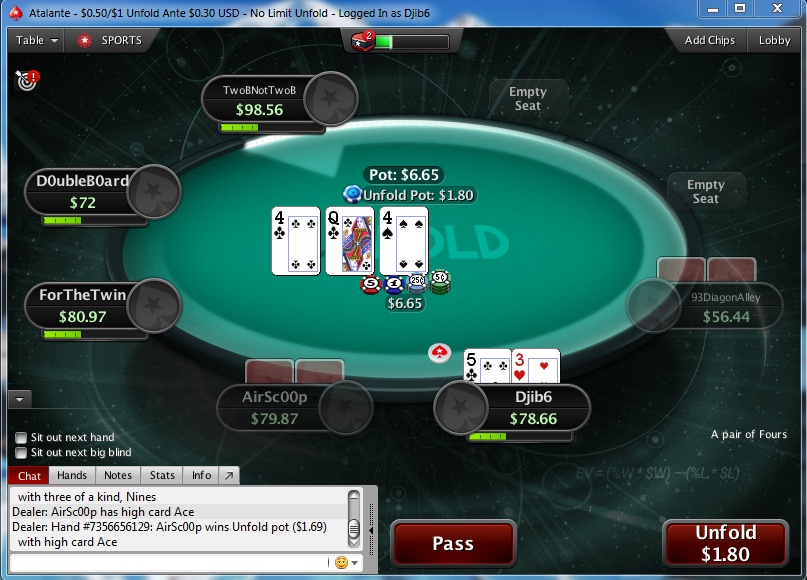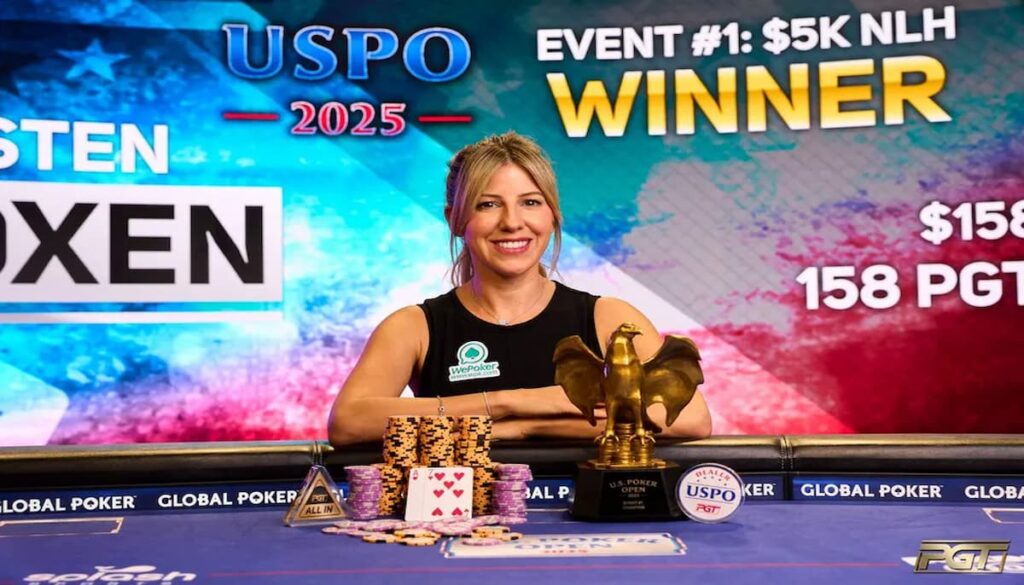UPDATE August 6: PokerStars has given Unfold a permanent place in the poker client. The game was planned to take its turn in a rotation of similar innovations, but now the poker room has decided that Unfold will be popular enough to justify more than a temporary promotion.
The latest in a series of game innovations at PokerStars was added to the poker client today. “Unfold” tweaks the traditional No Limit Hold’em cash game by giving players the option to unfold their hand after seeing the flop.
How Unfold works
The game changes work as follows:
- At the beginning of the hand each player pays an ante into a separate Unfold pot. The ante is a fixed percentage of the big blind.
- When the flop has been dealt players who have folded have the option to unfold their hand by making a bet equal to the size of the Unfold pot.
- Players who unfold do not take any further part in the betting.
- At the end of the pot, the unfold pot is awarded to the Unfold player with the strongest five card poker hand after the river is dealt.
- If the hand ends before the river, the remaining streets are dealt to determine the winner of the Unfold pot.
There are three circumstances where the Unfold antes are returned to all players. If:
- The main pot is decided pre-flop
- Fewer than two players fold pre-flop
- No players choose to Unfold
The game has been released for players at PokerStars sites in the .COM, .NET .UK, .EU and .DK markets with more promised, so, for example, New Jersey players might also get access to the new game.
In the incarnation of the game at the PokerStars.dk site in Denmark, the game is played at an eight seat table with a minimum of four players in each hand needed to trigger the unfold option.
The size of the ante varies according to the stakes. At the $0.01/0.02 stake level, the ante is 100 percent percent of the small blind. At the $0.25/$0.50 tables, the ante has been set at $0.15, 60 percent of the small blind. Notably, PokerStars does not take rake from the Unfold pot.
Players don’t get the option to table select, instead PokerStars is using its “Seat Me” option where players choose the stake they want to play at and are randomly seated at the first available table.
There’s no short-stacking available in the new game. Players must buy-in for between 60 and 80 big blinds.

How does Unfold change strategy?
The most obvious impact of the new game is that players get a second chance to win a pot. The size of that pot will depend on how many players are sat at the table and therefore contribute an ante, and how many players decide to Unfold their hand.
If only one player decides to Unfold, then that player will automatically win the Unfold pot.
The game neatly targets player psychology. Every poker player has experienced the angst of folding an apparently weak hand and then seen a flop which turns their worthless cards into a monster.
Unfold relieves that feeling of regret, and allows players to get back into the action with the chance to win a small pot. Of course if several players choose to unfold that small pot can become more meaningful.
Even when players choose to unfold on the flop, turn and river cards have still to be dealt which adds an element of chance to the outcome.
An apparently powerful flopped flush can easily turn into a losing hand if the board pairs and another player who has unfolded shows down with a full house.
Aggressive players will begin to unfold a higher percentage of their hands which aren’t “made” on the flop, but which have a good potential for improving when the last two community cards are dealt.
Position remains critical with players in later-to-act seats able to take advantage of the Unfold option knowing how many players have either exercised the option or let it pass.
Players who love doing poker math will get to calculate their expected value and begin to define what hand ranges are most profitable to unfold.
Will PokerStars Unfold take off?
Put the different aspects together, and the new game looks like it will appeal to both recreational players who will enjoy winning some money with a previously folded hand, and the more studious players who will be able to gain a small edge by developing a winning strategy.
On the downside, the game inevitably means that hands where the Unfold pot is in play will take a little longer. The industry trend has been to speed up games, not slow them down, so this will be a factor in the game’s success.
The fact that a player who chooses the unfold option isn’t guaranteed to win since the luck element remains, means that the decision to unfold or not is not necessarily automatic.
In game design theory this makes Unfold much more interesting and more likely to be popular. It is the mix of skill and luck which defines poker as a “mind sport” and that makes the game so attractive to such a large audience.
Players who can judge that it will be profitable to unfold with relatively weak hands, such as middle pair will enjoy plaudits for their prescience and judgment when they win.
When recreational players see other players win with weaker hands, they may well increase their use of the unfold option. While they will be relying more on luck than judgment, the positive effect when the decision leads to a win is one of the psychological factors which encourages them to keep playing.
Even though Unfold leaves the primary game unchanged, the option to give players a second chance looks to be a winner. It adds a dimension to the game that many players will enjoy.








